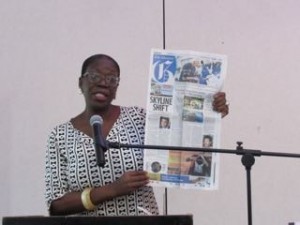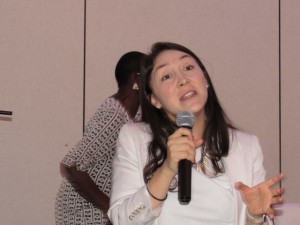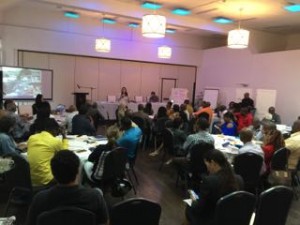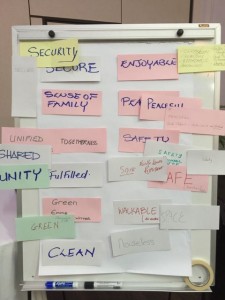
Prioritising People: The Rebuilding of a Kingston Neighbourhood
October 29th, 2018
There has been a lot of public debate recently about urban development: The new Parliament building, twenty-storey buildings, road widening – and the felling of our city’s trees, which I have written and tweeted about before. It’s all quite overwhelming. What of the people who live in the midst of this sea of concrete mixers and chainsaws and men in “high visibility” jackets? What of those who travel to and do business in these areas?
The complaints against various government agencies – notably the National Works Agency – have been endless, comprehensive, detailed. Many have focused on the inconvenience for motorists, and the monstrous traffic jams (I believe that improved and innovative public transportation solutions are the answer). Nowadays you could say that the city is being redesigned for the motor vehicle. However, a good few have questioned the impact of the concrete medians, barriers and the disappearance of many old trees on our way of life and doing things. What about the humble pedestrian? Including, of course, young children, seniors, the blind and other people with disabilities? Are they to simply get out of the way?
A week ago, a quite possibly groundbreaking workshop took place (yes, the participants actually did work – this was not a workshop in name only). The Golden Triangle Neighbourhood Association (GTNA), with the assistance of Clifton Yap Architects and the invaluable support of the National Housing Trust, had invited two urban planners from Medellín, Colombia to Jamaica to assist with the “Community Visioning” work. The aim is to make the Golden Triangle (a specific area wedged roughly between New Kingston and Liguanea, also called Seymour Lands) a “Livable Community for All.”
So, last week a group of over fifty residents and “stakeholders,” (businesses, churches, schools) came together, along with representatives of several Government agencies, to work out what would make the Golden Triangle neighbourhood more livable. Of course, livable meant different things to different people. To start with, that staple ingredient of workshops, the post-it sticker, came into play. Peaceful, secure, quiet, togetherness, walkable, clean, shared were some of the words that appeared on the stickies…
We were told by a representative of the National Environment and Planning Agency (NEPA) that the Provisional Development Order for the area is online, and that “people can comment” on it. Well, who knew. Here is the one for Kingston & St. Andrew and the Seymour Lands is described on p. 170. Several properties in the area are “hot spots” – including this one, and the old building on the corner of Hopefield Avenue and Lady Musgrave Road, which is, in fact, the original University College of the West Indies (in its infancy) and thus a heritage site. It is owned by the National Insurance Fund. Could it be a museum, with a surrounding park area?
But this is getting down into the weeds, and there is not space here to go into all the details. Suffice it to say that the following emerged from the day-long meeting:
- The GTNA is “not necessarily against” taller buildings or increased housing density.
- The GTNA is not opposed to “mixed use” (which it already has, with a number of small businesses and the new Inter-American Development Bank office in the area).
- There must be proper, meaningful consultations among stakeholders and all government agencies involved in planning – before houses are torn down and trees removed.
- The GTNA is opposed to Lady Musgrave Road becoming a four-lane highway with concrete medians à la Barbican (an area which has been a planning disaster). This major, historic route, approaching King’s House from downtown (and from the airport) could be a pleasant boulevard, with wide sidewalks, lined with poui trees. Why not?
- There are major concerns regarding infrastructure (sewage, drainage, and the “precious commodity” water), services such as garbage collection, and parking space. All these become bigger issues with increased population densities. They are hardly properly addressed now.
- A vastly increased amount of traffic and inadequate public transportation in and around the area is also a concern, as it is for the entire city. This creates higher emissions (do we care about sustainable cities?), air pollution and of course noise. Livable?
- The “de-greening” of the area is a concern. Whenever a large plot of land is purchased and an old building demolished, townhouses and apartments are built. In most cases, this means cutting down native and well-established trees and planting a few imported palm trees instead. Concrete for the parking of vehicles replaces green. Over the past decade, I would estimate that the whole area has lost about fifty per cent of its trees.
- This “upscale” area has very few public green spaces. Green cannot only be people’s yards; it must be public parks and recreational spaces. Enjoying and sharing public spaces is part of creating a livable community.
- Proper sidewalks are critical in many parts of the community.
This all looks like problems, problems, problems. However, the meeting was not focused on complaining and grousing.

Vice President of the GTNA Edith Williams holds up the front page of the Jamaica Gleaner: “Skyline Shift.” (My photo)
Many ideas for improving the Golden Triangle emerged. One was a rush-hour shuttle (tram) around the perimeter, dropping New Kingston workers off along the route in the mornings (the area has become a shortcut for commuters during rush hours). A “park and ride” system can and does work in many cities globally. Residents also wanted to see more cultural events, perhaps making one or two streets pedestrian-only for music or art festivals, or small concerts that would not disturb the neighbours. The idea is that space (including public space) can be managed in such a way that enhances wellbeing and is not harmful to others. How about a streetside yoga space, or a fitness park?
The GTNA and its Colombian partners would also like to see input from children, students from local schools. How do they imagine a park? As Elaine Wint put it, “intergenerational planning” is planning for future generations.

Juliana Quintero of EAFIT University in Medellin is a member of the team working on a new plan for the Golden Triangle. (My photo)
Interestingly, the need for greater security did not crop up as often as one would think (a member of the Jamaica Constabulary Force, – Inspector Michael Trail, Officer-in-Charge, Matilda’s Corner Police Station – was an active participant, by the way). However, Juliana Quintero Marin, an urban development and public administration specialist from EAFIT University in Medellín, remarked, “We don’t have walls like you do here.” Do walls keep us safer?
A good question. It may be that there are more questions than answers in all of this. But it is all about dialogue, collaboration, proper consultation – and hard work. As our Colombian friends said, you cannot plan a community from behind a desk, either (note to government bureaucrats).
Most important of all (and this, of course, applies to every neighbourhood in Jamaica) we must prioritize people.
Tags: children, Clifton Yap Architects, Colombia, deforestation, EAFIT University, Golden Triangle, Golden Triangle Neighbourhood Association, Inter-American Development Bank, Jamaica Constabulary Force, Juliana Quintero Marin, Kingston, Medellin, National Environment and Planning Agency, National Housing Trust, National Works Agency, NEPA, planning, public transport, Seymour Lands, sustainable development, traffic, urban living, water resource management
The Gleaner reserves the right not to publish comments that may be deemed libelous, derogatory or indecent.
To respond to The Gleaner please use the feedback form.
- We Are the Zoomers
- Living Online with Humans and Birds: NAOC 2020
- Human Trafficking and the Problem of Public Education
- Down Memory Lane
- Are We Ready to Recover from COVID-19?
- Road Safety Matters: Is Your Vehicle Safe?
- Sexual Harassment, Me Too, and the Minister’s Disturbing Giggle
- The Vulnerable Senior Citizens, Private Care Homes and COVID-19
- A Muddle Over Masks
- Here is Something Life-Saving You Can Do: Give Blood!





